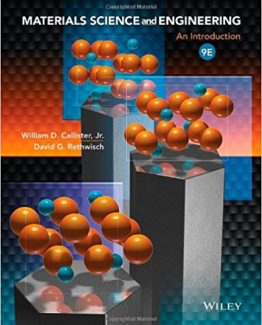21st Century Astronomy 5th Edition by Laura Kay, ISBN-13: 978-0393938999
[PDF eBook eTextbook]
A textbook that facilitates learning by doing.
Influenced by astronomy education research, 21st Century Astronomy offers a complete pedagogical and media package that facilitates learning by doing, while the new one-column design makes the Fifth Edition the most accessible introductory text available today.
Table of contents:
Cover (21st Century Astronomy)……Page 1
Half Title……Page 2
Title……Page 4
Copyright……Page 5
Dedication……Page 6
Brief Contents……Page 7
Contents……Page 8
Preface……Page 22
Acknowledgments……Page 30
About the Authors……Page 33
Chapter 1 – Thinking Like an Astronomer……Page 35
1.1 – Earth Occupies a Small Place in the Universe……Page 37
1.2 – Science Is a Way of Viewing the Universe……Page 40
1.3 – Astronomers Use Mathematics to Find Patterns……Page 45
Chapter 2 – Patterns in the Sky—Motions of Earth and the Moon……Page 55
2.1 – Earth Spins on Its Axis……Page 57
2.2 – Revolution about the Sun Leads to Changes during the Year……Page 66
2.3 – The Moon’s Appearance Changes as It Orbits Earth……Page 73
2.4 – Calendars Are Based on the Day, Month, and Year……Page 76
2.5 – Eclipses Result from the Alignment of Earth, Moon, and the Sun……Page 78
Chapter 3 – Motion of Astronomical Bodies……Page 91
3.1 – The Motions of Planets in the Sky……Page 93
3.2 – Kepler’s Laws Describe Planetary Motion……Page 97
3.3 – Galileo’s Observations Supported the Heliocentric Model……Page 102
3.4 – Newton’s Three Laws Help to Explain the Motion of Celestial Bodies……Page 104
Chapter 4 – Gravity and Orbits……Page 115
4.1 – Gravity Is a Force between Any Two Objects Due to Their Masses……Page 117
4.2 – An Orbit Is One Body “Falling around” Another……Page 122
4.3 – Tidal Forces Are Caused by Gravity……Page 128
4.4 – Tidal Forces Affect Solid Bodies……Page 132
Chapter 5 – Light……Page 141
5.1 – Light Brings Us the News of the Universe……Page 143
5.2 – The Quantum View of Matter Explains Spectral Lines……Page 150
5.3 – The Doppler Shift Indicates Motion Toward or Away from Us……Page 158
5.4 – Temperature Affects the Spectrum of Light That an Object Emits……Page 160
5.5 – The Brightness of Light Depends on the Luminosity and Distance of the Source……Page 165
Chapter 6 – The Tools of the Astronomer……Page 175
6.1 – The Optical Telescope Revolutionized Astronomy……Page 177
6.2 – Optical Detectors and Instruments Used with Telescopes……Page 185
6.3 – Astronomers Observe in Wavelengths Beyond the Visible……Page 188
6.4 – Planetary Spacecraft Explore the Solar System……Page 192
6.5 – Other Tools Contribute to the Study of the Universe……Page 194
Chapter 7 – The Birth and Evolution of Planetary Systems……Page 205
7.1 – Planetary Systems Form around a Star……Page 207
7.2 – The Solar System Began with a Disk……Page 210
7.3 – The Inner Disk and Outer Disk Formed at Different Temperatures……Page 214
7.4 – The Formation of Our Solar System……Page 218
7.5 – Planetary Systems Are Common……Page 220
Chapter 8 – The Terrestrial Planets and Earth’s Moon……Page 233
8.1 – Impacts Help Shape the Evolution of the Planets……Page 235
8.2 – Radioactive Dating Tells Us the Age of the Moon and the Solar System……Page 240
8.3 – The Surface of a Terrestrial Planet Is Affected by Processes in the Interior……Page 242
8.4 – Planetary Surfaces Evolve through Tectonism……Page 247
8.5 – Volcanism Signifies a Geologically Active Planet……Page 252
8.6 – The Geological Evidence for Water……Page 255
Chapter 9 – Atmospheres of the Terrestrial Planets……Page 267
9.1 – Atmospheres Change over Time……Page 269
9.2 – Secondary Atmospheres Evolve……Page 271
9.3 – Earth’s Atmosphere Has Detailed Structure……Page 276
9.4 – The Atmospheres of Venus and Mars Differ from Earth’s……Page 284
9.5 – Greenhouse Gases Affect Global Climates……Page 288
Chapter 10 – Worlds of Gas and Liquid—The Giant Planets……Page 301
10.1 – The Giant Planets Are Large, Cold, and Massive……Page 303
10.2 – The Giant Planets Have Clouds and Weather……Page 308
10.3 – The Interiors of the Giant Planets Are Hot and Dense……Page 314
10.4 – The Giant Planets Are Magnetic Powerhouses……Page 316
10.5 – The Planets of Our Solar System Might Not Be Typical……Page 320
Chapter 11 – Planetary Moons and Rings……Page 329
11.1 – Many Solar System Planets Have Moons……Page 331
11.2 – Some Moons Have Geological Activity and Water……Page 334
11.3 – Rings Surround the Giant Planets……Page 341
11.4 – Ring Systems Have a Complex Structure……Page 345
Chapter 12 – Dwarf Planets and Small Solar System Bodies……Page 359
12.1 – Dwarf Planets May Outnumber Planets……Page 361
12.2 – Asteroids Are Pieces of the Past……Page 365
12.3 – Comets Are Clumps of Ice……Page 370
12.4 – Meteorites Are Remnants of the Early Solar System……Page 377
12.5 – Collisions Still Happen Today……Page 381
Chapter 13 – Taking the Measure of Stars……Page 391
13.1 – Astronomers Measure the Distance, Brightness, and Luminosity of Stars……Page 393
13.2 – Astronomers Can Determine the Temperature, Size, and Composition of Stars……Page 398
13.3 – Measuring the Masses of Stars in Binary Systems……Page 404
13.4 – The Hertzsprung-Russell Diagram Is the Key to Understanding Stars……Page 409
Chapter 14 – Our Star—The Sun……Page 423
14.1 – The Sun Is Powered by Nuclear Fusion……Page 425
14.2 – Energy Is Transferred from the Interior of the Sun……Page 430
14.3 – The Atmosphere of the Sun……Page 436
14.4 – The Atmosphere of the Sun Is Very Active……Page 438
Chapter 15 – The Interstellar Medium and Star Formation……Page 453
15.1 – The Interstellar Medium Fills the Space between the Stars……Page 455
15.2 – Molecular Clouds Are the Cradles of Star Formation……Page 463
15.3 – Formation and Evolution of Protostars……Page 465
15.4 – Evolution Before the Main Sequence……Page 469
Chapter 16 – Evolution of Low-Mass Stars……Page 481
16.1 – The Life of a Main-Sequence Star Depends on Its Mass……Page 483
16.2 – The Star Leaves the Main Sequence……Page 486
16.3 – Helium Burns in the Degenerate Core……Page 489
16.4 – Dying Stars Shed Their Outer Layers……Page 493
16.5 – Binary Star Evolution……Page 499
Chapter 17 – Evolution of High-Mass Stars……Page 511
17.1 – High-Mass Stars Follow Their Own Path……Page 513
17.2 – High-Mass Stars Go Out with a Bang……Page 517
17.3 – The Spectacle and Legacy of Supernovae……Page 522
17.4 – Star Clusters Are Snapshots of Stellar Evolution……Page 528
Chapter 18 – Relativity and Black Holes……Page 539
18.1 – Relative Motion Affects Measured Velocities……Page 541
18.2 – Special Relativity Explains How Time and Space Are Related……Page 543
18.3 – Gravity Is a Distortion of Spacetime……Page 548
18.4 – Black Holes……Page 556
Chapter 19 – Galaxies……Page 567
19.1 – Galaxies Come in Different Shapes and Sizes……Page 569
19.2 – Astronomers Use Several Methods to Find Distances to Galaxies……Page 575
19.3 – Galaxies Are Mostly Dark Matter……Page 579
19.4 – Most Galaxies Have a Supermassive Black Hole at the Center……Page 582
Chapter 20 – The Milky Way—A Normal Spiral Galaxy……Page 597
20.1 – Astronomers Have Measured the Size and Structure of the Milky Way……Page 599
20.2 – The Components of the Milky Way Provide Clues about the Formation of Spiral Galaxies……Page 603
20.3 – Most of the Milky Way Is Unseen……Page 609
20.4 – The History and Future of the Milky Way……Page 613
Chapter 21 – The Expanding Universe……Page 623
21.1 – The Cosmological Principle……Page 625
21.2 – The Universe Began in the Big Bang……Page 630
21.3 – Expansion Is Described with a Scale Factor……Page 634
21.4 – Astronomers Observe Cosmic Microwave Background Radiation……Page 637
Chapter 22 – Cosmology……Page 649
22.1 – Gravity and the Expansion of the Universe……Page 651
22.2 – The Accelerating Universe……Page 653
22.3 – Inflation Solves Several Problems in Cosmology……Page 659
22.4 – The Earliest Moments of the Universe Connect the Very Largest Size Scales to the Very Smallest……Page 662
22.5 – String Theory and Multiverses……Page 669
Chapter 23 – Large-Scale Structure in the Universe……Page 679
23.1 – Galaxies Form Groups, Clusters, and Larger Structures……Page 681
23.2 – Gravity Forms Large-Scale Structure……Page 684
23.3 – First Light of Stars and Galaxies……Page 690
23.4 – Galaxies Evolve……Page 695
Chapter 24 – Life……Page 707
24.1 – Life Evolves on Earth……Page 709
24.2 – Life Involves Complex Chemical Processes……Page 714
24.3 – Where Do Astronomers Look for Life?……Page 717
24.4 – Scientists Are Searching for Signs of Intelligent Life……Page 722
APPENDIX 1 – Mathematical Tools……Page 734
APPENDIX 2 – Physical Constants and Units……Page 739
APPENDIX 3 – Periodic Table of the Elements……Page 741
APPENDIX 4 – Properties of Planets, Dwarf Planets, and Moons……Page 742
APPENDIX 5 – Space Missions……Page 746
APPENDIX 6 – Nearest and Brightest Stars……Page 748
APPENDIX 7 – Observing the Sky……Page 751
APPENDIX 8 – Uniform Circular Motion and Circular Orbits……Page 760
APPENDIX 9 – IAU 2006 Resolutions: “Definition of a Planet in the Solar System” and “Pluto”……Page 762
Glossary……Page 764
Selected Answers……Page 780
Credits……Page 786
Index……Page 790
About the Author
Laura Kay is Ann Whitney Olin professor and Chair of the Department of Physics and Astronomy at Barnard College, where she has taught since 1991. She received a BS degree in physics and an AB degree in feminist studies from Stanford University, and MS and PhD degrees in astronomy and astrophysics from the University of California–Santa Cruz. As a graduate student she spent 13 months at the Amundsen Scott station at the South Pole in Antarctica, and has had fellowships in Chile and Brazil. She studies active galactic nuclei using optical and X-ray telescopes. At Barnard she teaches courses on astronomy, astrobiology, women and science, and polar exploration.
What makes us different?
• Instant Download
• Always Competitive Pricing
• 100% Privacy
• FREE Sample Available
• 24-7 LIVE Customer Support






Reviews
There are no reviews yet.